Wednesday 15 April 1942
The Japanese are advancing across Mindanao in the Philippines, so the US military begins destroying equipment. This includes motor torpedo boat PT-41. US Navy Motor Torpedo Squadron 3 is disbanded for want of boats.
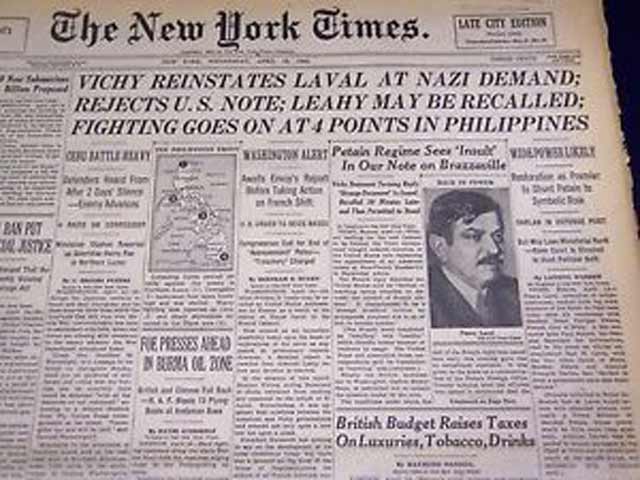 |
| Pierre Laval's return to power in Vichy Franch is the big news in the 15 April 1942 New York Times. |
Battle of the Indian Ocean: The Japanese offensive north in the Irrawaddy River valley of Burma continues unabated (the Japanese 55th Infantry Division captures Thawatti), so Allied local commander Lieutenant-General William Slim basically accepts defeat. He orders the oil fields and refinery at the Yenangyaung oil fields to be demolished, and this is done during the day. Since the situation is falling apart, General Harold Alexander, commander of the Burma Army, pleads with US Lieutenant General Joseph Stilwell to have Chiang Kai-shek move the Chinese 38th Division into the area. The real question now, however, is not whether the Allies can hold at Yenangyaung, but whether the troops still trying to defend it still have time to escape before they are encircled.
The American Volunteer Group (AVG, or "Flying Tigers") remains a bright spot in the Allied presence in Burma. The US Army begins the process of making it an official US Army unit by recalling its leader, Claire Chennault, to active duty as a colonel.
Eastern Front: It is a quiet day on the Eastern Front as both sides await the full onset of the spring thaw ("Rasputitsa"). The only real activity is the breakout attempt at Demyansk toward the relief force commanded by General Seydlitz. General Franz Halder sums up the day's activity laconically in his war diary:
Battle of the Mediterranean: Due to the gallant stand of island residents against the sustained Axis air assault, King George VI awards the George Cross to the entire island of Malta. This is made in a letter to Lieutenant-General Sir William Dobbie, the island's governor. This award will be incorporated into the island's flag. The actual George Cross is in the National War Museum in Malta.
French Government: Premier Philippe Petain officially announces what everyone already knows, that Pierre Laval will lead a new government. This marks a drastic lurch in French politics in favor of supporting the German war effort. Admiral Leahy, the US ambassador to Vichy France, prepares to return to the United States by the end of the month as a sign of US disapproval.
Holocaust: The new death camp at Sobibor on the River Bug in Poland opens around this date. The first inmates are 30-40 Jewish women brought by rail from the nearby labor camp at Krychów. Christian Wirth, commander of Bełżec extermination camp and an inspector of new camps, arrives to witness the extermination of these women using experimental gassing techniques. The extermination equipment is crude, simply a truck engine placed on a cement slab with its exhaust piped into a wooden chamber, but effective. At this stage, the mass exterminations have not yet begun - that starts on 16 May 1942. But the killings have begun.
French Homefront: A trial of leaders of the French Third Republic being held in the city of Riom (the "Riom Trial") in central France is called off (adjourned sine die) because it has begun to embarrass the Petain government. The original intent of the show trial was to pin the 1940 defeat on Leon Blum's Popular Front government in office at the time. In the German view, the invasion of France occurred because France first invaded German territory (which technically is true, though it ignores why that happened). The Germans have assumed that this French aggressiveness would be an easy and quick case for the Petain government to make and thus initially were happy that the trial was taking place.
Eastern Front: It is a quiet day on the Eastern Front as both sides await the full onset of the spring thaw ("Rasputitsa"). The only real activity is the breakout attempt at Demyansk toward the relief force commanded by General Seydlitz. General Franz Halder sums up the day's activity laconically in his war diary:
Situation: Unchanged. On the whole, all quiet. At Staraya Russa [the Demyansk breakout], our attack gains some ground.
Halder remains preoccupied with getting troops in position for the big summer offensive planned for southern Russia. He notes that "Men with two months training must be sent directly to the combat units," which is a month less than usual but necessary given manpower shortages.
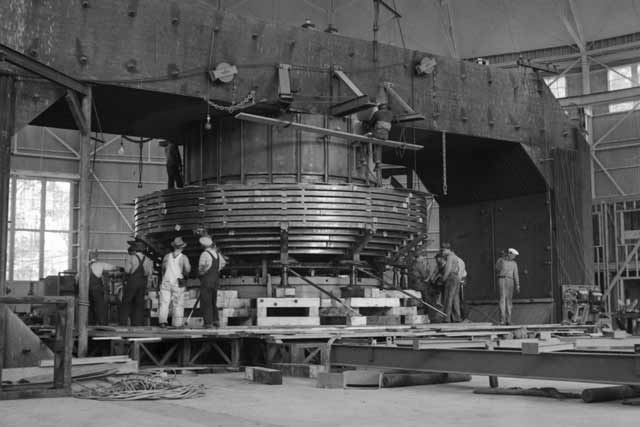 |
| The 184-inch cyclotron under construction at the Berkeley Lab, 15 April 1942 (US National Archives). |
European Air Operations: The renewed Luftwaffe presence on the Channel Front pursuant to Adolf Hitler's demand that for retaliation for the RAF raid on Lubeck begins to make its presence felt. While some planes do some typical minelaying near Tynemouth around midnight, others continue flying inland and bomb Berwickshire, Northumberland, Durham, and the North Riding. There is one death and two injuries in West Hartlepool, while 26 are killed and 52 wounded in Middleborough, Yorkshire. There is widespread damage to infrastructure and 39 homes are destroyed.
RAF attacks also are causing damage. Bombing runs on Le Havre, France, during the night of 14/15 April sink Kriegsmarine minesweepers M 3810 and M 4603. During the day, nine Boston bombers attack Cherbourg without loss.
After dark, RAF Bomber Command stages a follow-up raid to Dortmund, the target of 14/15 April. It sends 152 bombers (111 Wellingtons, 19 Hampdens, 15 Stirlings, 7 Manchesters) to Dortmund at a cost of three Wellingtons and a Stirling. As has been typical recently, cloud-cover and icing wreak havoc on the bombers' navigation and most of the bombers drop their bombs somewhere other than the target. Only one house is destroyed and 13 damaged in Dortmund itself, with two people killed and six wounded. In other operations, 18 Whitleys bomb St. Nazaire, 8 Wellingtons bomb Le Havre, four Blenheims bomb the Netherlands, four bombers drop leaflets on France, and 11 bombers lay mines off St. Nazaire.
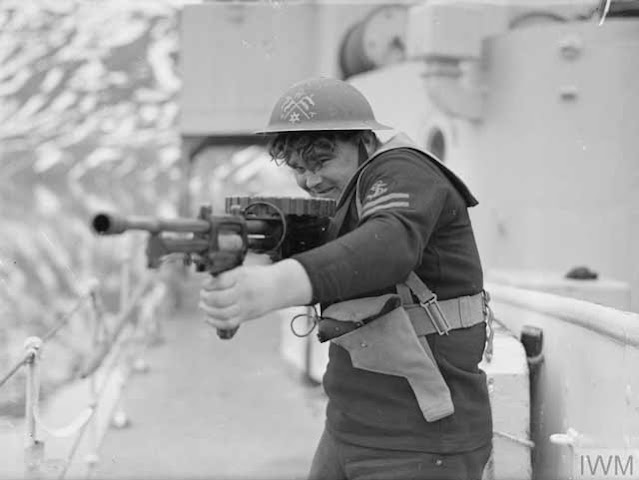 |
| Practicing boarding-party techniques with a Tommy gun aboard HMS Wheatland, 15 April 1942 (© IWM A 8538). |
Battle of the Atlantic: Most of the activity today is in the Arctic. The Luftwaffe bombs Murmansk and sinks one freighter and damages another. Luftwaffe reconnaissance aircraft spot Convoy PQ-14, giving the Germans plenty of time to prepare attacks for when it passes close to the Norwegian coast. Soviet submarine K-2 lays a minefield off Vardo, Norway. The Kriegsmarine has three U-boats in position to attack QP-10, a convoy that already has been mauled on its way from Murmansk to Iceland, but they fail to score any successes.
Battle of the Mediterranean: Due to the gallant stand of island residents against the sustained Axis air assault, King George VI awards the George Cross to the entire island of Malta. This is made in a letter to Lieutenant-General Sir William Dobbie, the island's governor. This award will be incorporated into the island's flag. The actual George Cross is in the National War Museum in Malta.
 |
| State Secretary Gutterer (left) presenting sculptor Georg Kolbe (center) the Goethe Medal for Art and Science, personally awarded to Koble by Adolf Hitler. 15 April 1942 (Schwahn, Federal Archive Image 183-J01121). |
Holocaust: The new death camp at Sobibor on the River Bug in Poland opens around this date. The first inmates are 30-40 Jewish women brought by rail from the nearby labor camp at Krychów. Christian Wirth, commander of Bełżec extermination camp and an inspector of new camps, arrives to witness the extermination of these women using experimental gassing techniques. The extermination equipment is crude, simply a truck engine placed on a cement slab with its exhaust piped into a wooden chamber, but effective. At this stage, the mass exterminations have not yet begun - that starts on 16 May 1942. But the killings have begun.
 |
| Following the drastic tax increase on tobacco products by Minister Kingsley on 14 April, long queues form at tobacco shops that have not yet raised their prices on 15 April 1942 (AP Photo). |
However, the trial has turned out differently than the Germans expected. The defense has argued convincingly that the only fault was the lack of French defensive preparations, as opposed to an overly-aggressive posture by the Blum government (meaning, France was the victim rather than the Reich). Given this turn of events, German Ambassador Otto Abetz orders Pierre Laval, recently reinstalled as the de facto leader of the Petain government, to end the trial because Hitler has decided it no longer serves his purposes. The trial never resumes and is quietly ended on 21 May 1943.
British Homefront: The Churchill government continues clamping down on non-essential production in increasingly minute ways. The board of trade bans, as of 1 June 1942, various decorations on women's and girl's underwear. The new rules require no more than three buttons on skirts, six seams, only one pocket, and two box pleats or four knife pleats. Some of the rules apply to male attire, as double-breasted suits are not to be sold and pockets are restricted on pajamas.
Future History: Kenneth Lee Lay is born in Tyrone, Missouri. He joins the Officer Candidate School for the United States Navy in 1968 and ultimately rises to the rank of lieutenant with staff positions in the Pentagon. He exits the government in 1974 and, based on various contacts developed during his government service, becomes a top businessman in the energy field. Lay's company, Enron, files for bankruptcy in 2001. It becomes the biggest bankruptcy in United States history, and Lay is indicted on numerous counts of securities fraud and other crimes. He is convicted on ten counts but dies on 5 July 2006 of a heart attack before he can be sentenced.
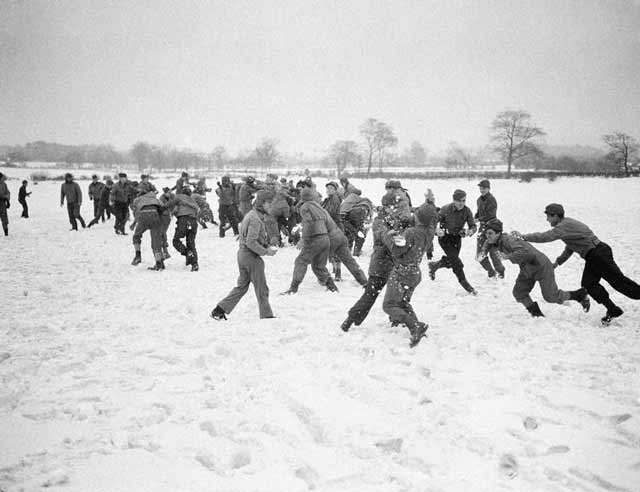 |
| US Army troops in Northern Ireland having a snowball fight, 15 April 1942 (AP Photo). |
American Homefront: Feelings against Japan are hard, and that translates to harshness toward Japanese-Americans, too. In response to a request for help when a local sheriff arrests a Japanese-American family trying to relocate lawfully from Tacoma to Klamath County to avoid internment, Oregon Governor Sprague responds:
they are to be escorted to Portland when the military authority issues the necessary order, and they will be cared for as other Japanese of the coastal area are to be cared for.
The rationale given by the local sheriff for arresting the Japanese-Americans is that he "fears mob violence" if unknown Japanese-Americans suddenly appear in the area. Basically, there is no way for such folks to avoid internment.
Future History: Kenneth Lee Lay is born in Tyrone, Missouri. He joins the Officer Candidate School for the United States Navy in 1968 and ultimately rises to the rank of lieutenant with staff positions in the Pentagon. He exits the government in 1974 and, based on various contacts developed during his government service, becomes a top businessman in the energy field. Lay's company, Enron, files for bankruptcy in 2001. It becomes the biggest bankruptcy in United States history, and Lay is indicted on numerous counts of securities fraud and other crimes. He is convicted on ten counts but dies on 5 July 2006 of a heart attack before he can be sentenced.
Juliana Edith Sommars is born in Fremont, Nebraska. As Julie Sommars, she becomes a well-known television actress in the United States, making her debut in 1960. She wins a Golden Globe for her role in the 1969-70 television series "The Governor & J.J." After that, Sommars became a regular guest star on numerous popular TV series of the 1970s and 1980s. As of 2020, Julie Sommars appears to have retired from acting.
Sven Erik Fernström is born in Solna, Sweden. As Jerry Williams, in 1962, he becomes a member of The Violents, a Swedish rock group associated with prominent British group The Shadows. Williams becomes the frontman and lead singer and later embarks on a successful career with other acts. Jerry Williams remains active in the Swedish music until his death on 25 March 2018.
April 1942
April 1, 1942: Convoys Come to the USAApril 2, 1942: Doolittle Raiders Leave Port
April 3, 1942: Japanese Attack in Bataan
April 4, 1942: Luftwaffe Attacks Kronstadt
April 5, 1942: Japanese Easter Sunday Raid on Ceylon
April 6, 1942: Japanese Devastation In Bay of Bengal
April 7, 1942: Valletta, Malta, Destroyed
April 8, 1942: US Bataan Defenses Collapse
April 9, 1942: US Defeat in Bataan
April 10, 1942: The Bataan Death March
April 11, 1942: The Sea War Heats Up
April 12, 1942: Essen Raids Conclude Dismally
April 13, 1942: Convoy QP-10 Destruction
April 14, 1942: Demyansk Breakout Attempt
April 15, 1942: Sobibor Extermination Camp Opens
April 16, 1942: Oil Field Ablaze in Burma
April 17, 1942: The Disastrous Augsburg Raid
April 18, 1942: The Doolittle Raid bombs Japan
April 19, 1942: British in Burma Escape
April 20, 1942: The Operation Calendar Disaster
April 21, 1942: Germans Relieve Demyansk
2021
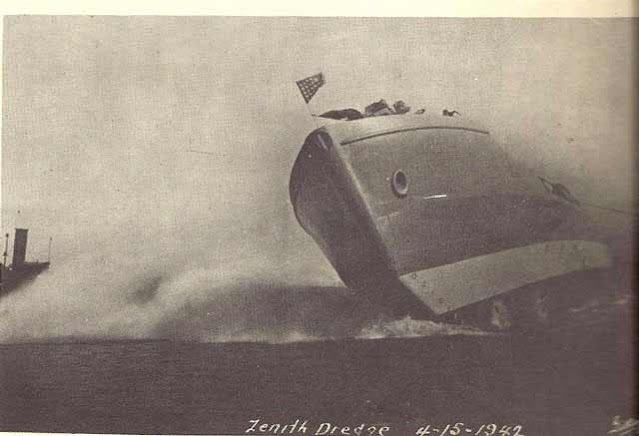

No comments:
Post a Comment